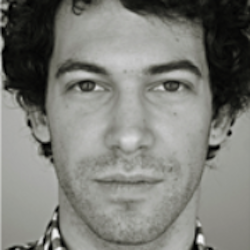Chinwag Psych Interview: Fabian Stelzer "Changing Design to affect Consumer Decisions"

Tomorrow is the day for our Chinwag Psych event where attendees can learn from the experts working with psychology, machine learning and neuroscience in business.
If you fancy a little food for your brain, grab a ticket and join us, it’s going to be a packed event with more than enough to inspire.
One of the great speakers in our lineup is Fabian Stelzer, co-founder and CEO of EyeQuant.
 EyeQuant helps businesses by applying neuroscience to online marketing, and the results can be astonishing. What goes on in the brain and how we look at the online world should be something taken into account when designing and presenting information anywhere. As the web’s business population grows, it’s essential to get things right.
EyeQuant helps businesses by applying neuroscience to online marketing, and the results can be astonishing. What goes on in the brain and how we look at the online world should be something taken into account when designing and presenting information anywhere. As the web’s business population grows, it’s essential to get things right.
At Chinwag Psych, Stelzer will be presenting a study that EyeQuant’s scientific advisors at the California Institute of Technology recently published.
“Marketers for the last couple of hundred years had this idea that attention is an important concept in selling,” says Stelzer. “That's a given. At the same time, currently in marketing sciences, we don't really know how attention alters perception and consumer decisions.”
The study Stelzer will present used a specific algorithm from EyeQuant to investigate how design changes affect consumer decisions in a supermarket scenario.
Hungry subjects were shown snack items which they ranked according to preference. Then using a virtual reality supermarket scene where these items were set out, they were asked to make another decision about what they wanted.
Designs were changed in different versions of the test and it showed that consumer choices can be manipulated in ways where some items get chosen more often. We won’t give the punchline away as Stelzer has plenty to share with us at the event, but the study results are intriguing and have an impact in both online and offline scenarios.
“This is the first time that neuroscientists have looked specifically into the relationship between consumer attention and consumer decisions,” explains Stelzer.
“It's already a kind of arms race,” he continues. “But the rules are becoming more complicated because the way that visual attention works. It's not as though you can find some perfect spot and colour that will stand out and you can stick with it.
“If you decide to make all your products red because red is an attention grabbing colour, that's not going to work if everyone does the same thing.”
Attention grabbing
The supermarket study is the first time that EyeQuant has been used for a scenario outside of the Internet. Theoretically this means that the company has a technological framework that is capable of being expanded into the real world.
This is a big step for the company that has evolved from ground-breaking academic research into a company that helps others work out better ways to communicate.
EyeQuant’s origins lie in the research of three neuroscientists who are now on board with the company.
“The fathers of contemporary attention research - Professor Christof Koch and Professor Laurent Itti developed the first saliency map algorithms that allow for attention prediction,” Stelzer explains.
The research was not initially designed for commercial use but out of the motivation to be able to understand attention better. Naturally though, understanding what goes on in the human brain can be very lucrative.
Stelzer says that eye movements are not governed by will power but rather by the world around us and its stimuli. “The brain has to filter out a lot of stuff,” he says. “The human eye processes roughly 10 Million Bits per second. The brain has to have mechanisms to work out which stuff is interesting and relevant”
It was Professor Peter König, now an EyeQuant cofounder who was also working with Koch and Itti who came up with a way of applying their algorithms in a narrower way on specific domains. “We started to do a lot of eyetracking studies to gather more insight and data on how people look at websites and this was the genesis of EyeQuant,” says Stelzer.
There is still a great deal to learn about the brain so EyeQuant is involved in continuous research. Currently the team is working on another large study looking at the differences in viewing behaviour when it comes to website front pages and product pages.
“The motivation is that we can roll out specific models that are not only predictive for landing pages but also predictive for product pages and returning visitors,” says Stelzer.
A ‘cognitologist’?
Stelzer has a background in cognitive science. It’s an interesting field for research, but he feels that there could be more made of the practical applications available to students after they graduate.
“For me, studying cognitive science was interest driven,” he says. “But when I was studying, a lot of my fellow students were wondering ‘What am I ever going to do with this?’”.
“There was a paper published at my university advising students on employability,” he continues. “This was in 1999 and the university recommended that students of cognitive science call themselves ‘cognitologists’ rather than cognitive scientists because it sounded more practical.”
Luckily Stelzer was quite confident that cognitive science and neurosciences would become an important part of the way people find jobs and found their own companies, but he admits that it took time.
Better business through scientific method
EyeQuant’s academic ties put the company in a strong position with access to cutting edge research. Stelzer points out that having the California Institute of Technology as a shareholder in his company means that they have access to what he says is one of the “most hard core neuroscience institutions in the world”.
Not only is the research important, scientific method also provides a stronger foundation for the work that is done at EyeQuant.
“The main scientific method in marketing at the moment is AB testing,” says Stelzer. “You can quickly gather meaningful experimental data in this way.”
“But one thing that is missing when businesses take on this process is peer review. Often the AB testing done in companies is performed in a way where decisions are based on data that might not be 100% statistically valid. These are mistakes that would be spotted in the peer review process but not all businesses have that process available to them which means it could be a bit more error prone, even if the data opportunity is massive.”
To find out more about the work that is being done at EyeQuant and of course what actually happened in that intriguing supermarket study, you’d best pick up a ticket to the Chinwag Psych event.
There are some great minds sharing their knowledge and maybe you will find a scientific method that can push your business to greater success.
Photo (cc) Hey Paul Studios



